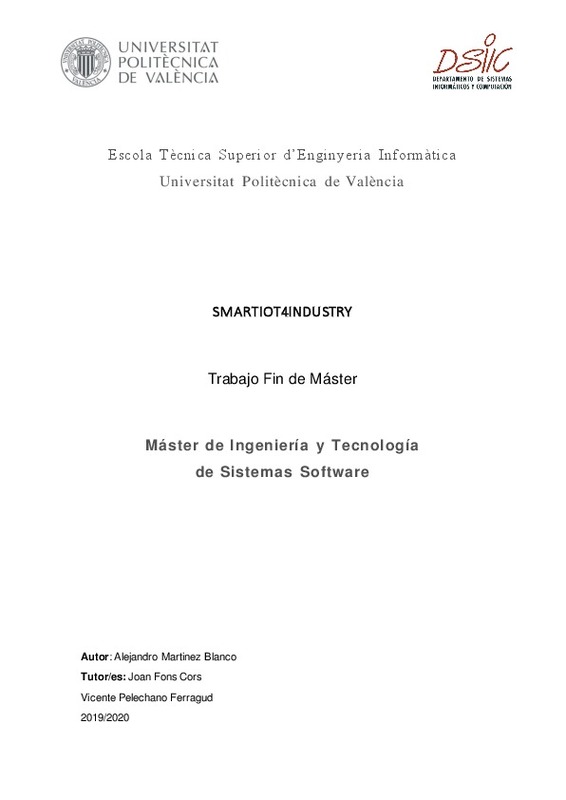JavaScript is disabled for your browser. Some features of this site may not work without it.
Buscar en RiuNet
Listar
Mi cuenta
Estadísticas
Ayuda RiuNet
Admin. UPV
SmartIoT4Industry
Mostrar el registro sencillo del ítem
Ficheros en el ítem
| dc.contributor.advisor | Fons Cors, Joan Josep
|
es_ES |
| dc.contributor.advisor | Pelechano Ferragud, Vicente
|
es_ES |
| dc.contributor.author | Martínez Blanco, Alejandro
|
es_ES |
| dc.date.accessioned | 2020-09-04T10:31:56Z | |
| dc.date.available | 2020-09-04T10:31:56Z | |
| dc.date.created | 2020-07-21 | |
| dc.date.issued | 2020-09-04 | es_ES |
| dc.identifier.uri | http://hdl.handle.net/10251/149426 | |
| dc.description.abstract | [EN] The term "Industry 4.0" was first used at the Hannover Fair in 2011. The concept of Industry 4.0 encompasses the intention to connect people, machines and products for efficient production and value-added processes to the digital network also known as Smart Factory [1]. Therefore, the concept exploits the idea of highly connected and automated machines, which use network resources and interfaces to autonomously monitor their work and the surrounding environment. One of the main problems currently faced by this novel idea of "Industry 4.0" is that it tries to bring together technologies that are completely different from each other, which by themselves and without the interaction with the different components of the production system and with other deployed technologies are not capable of providing the desired added value, since without a defined communication architecture and standard processes it is complicated for all systems to be correctly integrated into the industrial control platform. Taking as a basis the ideas of the industry 4.0 and starting from an IoT architecture, along this document a communication architecture has been designed where the different actors of the productive system together with the introduction of new disciplines in the field of autonomous and adaptive computing can communicate in a natural way and providing the system with self-adaptation evolving the Industry 4.0 from "the industrial automation process" to the "autonomous IoT industry". | es_ES |
| dc.description.abstract | ES] El término "Industria 4.0" fue utilizado por primera vez en la Feria de Hannover en el 2011. El concepto de Industria 4.0, engloba la intención de conectar personas, máquinas y productos para la producción eficiente y procesos de valor agregado a la red digital también conocida como Fábrica Inteligente o Smart Factory (CATANIA). Por lo tanto, el concepto explota la idea de máquinas altamente conectadas y automatizadas, que usan recursos e interfaces de red para monitorear de forma autónoma su trabajo y el entorno circundante. Uno de los principales problemas a los que se enfrenta actualmente esta novedosa idea de "Industria 4.0", es que trata de aunar tecnologías complemente diferentes entre sí, que por sí solas y sin la interacción con los diferentes componentes del sistema productivo y con otras tecnologías desplegadas no son capaces de aportar el valor añadido buscado, ya que sin una arquitectura de comunicación y procesos estándares definidos es complicado que todos los sistemas se integren correctamente en la plataforma de control industrial. Tomando como bases las ideas de la industria 4.0 y partiendo de una arquitectura IoT, a lo largo de este documento se ha diseñado una arquitectura de comunicación donde los diferentes actores del sistema productivo junto con la introducción de nuevas disciplinas en el ámbito de la computación autónoma y adaptativa puedan comunicarse de manera natural y dotando al sistema de auto adaptación evolucionando la Industria 4.0 desde "el proceso de automatización industrial" a la "industria IoT autónoma" | es_ES |
| dc.format.extent | 95 | es_ES |
| dc.language | Español | es_ES |
| dc.publisher | Universitat Politècnica de València | es_ES |
| dc.rights | Reserva de todos los derechos | es_ES |
| dc.subject | Industria 4.0 | es_ES |
| dc.subject | Interfaces multimodales | es_ES |
| dc.subject | IoT | es_ES |
| dc.subject | Auto adaptación | es_ES |
| dc.subject | Lenguaje natural | es_ES |
| dc.subject | Industria IoT autónoma. | es_ES |
| dc.subject | Industry 4.0 | es_ES |
| dc.subject | Multimodal interfaces | es_ES |
| dc.subject | Self-adaptation | es_ES |
| dc.subject | Natural language | es_ES |
| dc.subject | Autonomous IoT industry. | es_ES |
| dc.subject.classification | LENGUAJES Y SISTEMAS INFORMATICOS | es_ES |
| dc.subject.other | Máster Universitario en Ingeniería y Tecnología de Sistemas Software-Màster Universitari en Enginyeria i Tecnologia de Sistemes Programari | es_ES |
| dc.title | SmartIoT4Industry | es_ES |
| dc.type | Tesis de máster | es_ES |
| dc.rights.accessRights | Abierto | es_ES |
| dc.contributor.affiliation | Universitat Politècnica de València. Departamento de Sistemas Informáticos y Computación - Departament de Sistemes Informàtics i Computació | es_ES |
| dc.description.bibliographicCitation | Martínez Blanco, A. (2020). SmartIoT4Industry. http://hdl.handle.net/10251/149426 | es_ES |
| dc.description.accrualMethod | TFGM | es_ES |
| dc.relation.pasarela | TFGM\100650 | es_ES |






